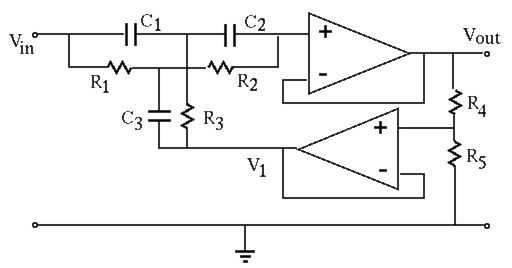Next: Wien bridge Up: Chapter 6: Active Filter Previous: The Sallen-Key filters
The twin-T filter

The twin-T network is composed of two T-networks:
 and one
capacitor
and one
capacitor  .
.
 and one
resistor
and one
resistor  .
.
By simple observation we see that when the output is an open-circuit with



 |
 |
 |
|
 |
 |
(36) |
 (37)
(37)
 to zero:
to zero:
 (38)
(38)
This result can also be reached by noticing the following
 (39)
(39)
When this notch filter is used in a negative feedback loop of an amplifier, it becomes an oscillator.

The active twin-T filter
The bandwidth




Now the common terminal of the twin-T filter is no longer grounded,
instead it is connected a potentiometer, a voltage divider composed
of 


 (40)
(40)
 , i.e.,
, i.e.,
 .
.
The input and output of the twin-T network are respectively 


 (41)
(41)
 , we get
, we get
 |
 |
 |
|
 |
 |
(42) |
 (43)
(43)
 we get
we get
 |
 |
 |
|
 |
 |
||
 |
 |
||
 |
 |
(44) |
 (45)
(45)
 and
and  , the bandwidth
, the bandwidth
 can be adjusted. In particular,
can be adjusted. In particular,
 ,
,  (no feedback),
(no feedback),
 ,
,
 ;
;
 ,
,  (one hundred percent feedback),
(one hundred percent feedback),
 ,
,
 .
.
The bridged T filter
If in the RCR T-network the vertical capacitor branch is dropped,
i.e., 


 (46)
(46)
 |
 |
 |
|
 |
 |
||
 |
 |
(47) |
 , and express both the numerator and the
denominator in the canonical form as
, and express both the numerator and the
denominator in the canonical form as
 (48)
(48)
 (49)
(49)
 ,
,

 ,
, 
 ,
,
